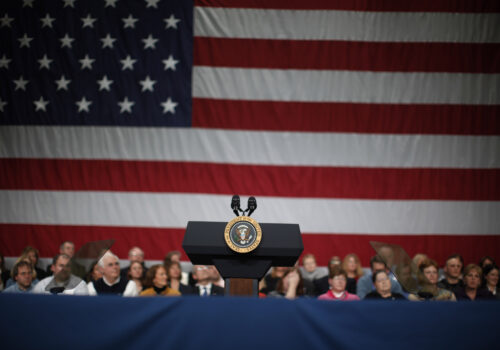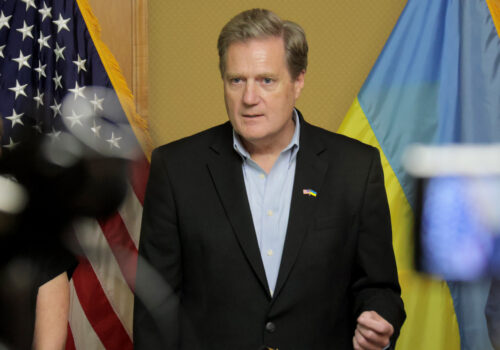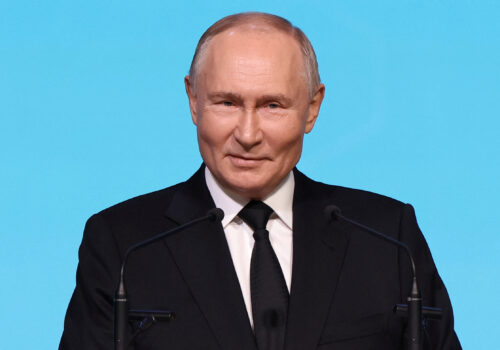Trump is inheriting a more dangerous world
After his January inauguration, US President Donald Trump will confront a far more dangerous world than he did during his first term, characterized by intractable wars in Europe and the Middle East, as well as increasing tensions with China over Taiwan.
What’s new as well is a burgeoning defense industrial and political alignment among four autocratic partners—China, Russia, North Korea, and Iran. Even as Trump recruits his national security team, fifty thousand Russian and North Korean soldiers are poised for battle on Russian soil against Ukraine.
None of these challenges would have been any different if Vice President Kamala Harris had been elected president.
The dramatic difference will be in how Trump confronts these generational challenges, deploying his proudly unpredictable and disruptive leadership style alongside his more transactional approach to allies and adversaries alike.
Trump has never been one to think about the world in Kissingerian terms, and he’s unlikely now to speak to the American public in the lofty terms of “grand strategy.” That’s what academics call the approach to how a country can stitch together military and nonmilitary means to achieve national interests designed for longer-term outcomes.
Yet that is precisely what’s required as the United States navigates the opening years of a new era that began before Trump’s reelection and likely will continue after it. To prevail, it will take grand strategy’s combination of military doctrine, force structure, alliances, economic relations, diplomatic behavior, technological leadership, societal strengths, and the mobilization of sufficient methods and resources.
Though it’s always tempting to think about what can be achieved in a single presidential term, such eras are more often defined through several presidencies and the opposing powers and events that punctuate them.
The last time the United States confronted such an opposing group of autocrats was in the opening years of the Cold War, when the country and its allies faced off against Nikita Khrushchev’s Soviet Union, its Warsaw Pact allies, and Mao Zedong’s Communist China.
That era’s central conflict was resolved by the Cuban Missile Crisis in October 1962, when the Soviet Union stepped back from the brink of a potential nuclear conflict. It then took nearly three decades more of relatively steady US commitment and allied common cause to win the Cold War, following the Berlin Wall’s fall and the Soviet Union’s collapse.
Before that in the late 1930s, three autocratic powers—Hitler’s Germany, Mussolini’s Italy, and Imperial Japan—combined their efforts in far less coordinated terms than today’s “axis of aggressors.” That period ended only after the United States’ entry into World War II in December 1941, which was followed by Italy’s surrender in September 1943, Germany’s surrender in May 1945, and then Japan’s surrender in September 1945, after the atomic bombing of Hiroshima and Nagasaki.
The lesson of both those experiences is that such conflicts don’t resolve themselves. In both cases, the decisions of US presidents were crucial to the outcomes, as will be the case again. (See my October 19 Inflection Points column explaining why it is that Americans were electing a “wartime president.”)
If previous experience is any guide, Trump is likely to take on this emerging era more tactically than strategically, dealing with China, Russia, Iran, and North Korea as individual challenges. Even some former Trump administration officials don’t believe that will be sufficient for the much-altered geopolitical landscape.
A former Trump White House official, quoted in the Wall Street Journal on November 9, said, “With North Korean soldiers serving with the Russians to kill Ukrainians using Iranian missiles, who are selling their oil to the Chinese, just the interconnectedness of all these different policy areas is something we didn’t have. We could have a discrete North Korea policy. We could have a discrete Iran policy. Now it’s got to be done more holistically.”
That said, Trump also brings instincts and approaches that could help disrupt this axis of aggressors, even if executed on a tactical basis.
Trump is likely to take a far tougher approach than President Joe Biden toward Iran, against which Trump pursued a “maximum pressure” campaign of sanctions and other measures in his first term. He is also likely to be more supportive of Israeli actions against Iran. That may be even more the case after the Justice Department disclosed on Friday that the Federal Bureau of Investigation had foiled an Iranian plot to assassinate Trump before the election.
Regarding Russia, Trump will bring an element of personal diplomacy with Russian President Vladimir Putin that Biden has lacked since their last direct conversation in February 2022.
The question for Ukraine is whether that is a bad or good thing. The advisers with Trump’s ear range from those who believe he should drastically reduce support for Ukraine to those who believe he needs to do far more.
On Thursday, Trump spoke by phone with Putin, and a person familiar with the call has told reporters that the president-elect advised the Russian leader not to escalate the war in Ukraine and reminded him of Washington’s large military presence in Europe. (The Kremlin denied the conversation took place.) Trump reportedly expressed interest in follow-up conversations to seek an early resolution of the war.
The war in Ukraine stands out as the most significant of the immediate challenges Trump faces, as failure there will only encourage China in its ambitions to forcefully absorb Taiwan—and also encourage Putin to press his advantage elsewhere.
“The greatest national security threat to the United States, its fellow NATO members, and other US allies is the increasingly aggressive partnership of Russia, China, Iran, and North Korea,” the Atlantic Council’s John Herbst, former US ambassador to Ukraine, wrote last week. “It is not clear that Trump fully acknowledges this challenge,” Herbst added. “But whether he understands it or not, his administration will have to deal with it and its most dangerous point of confrontation: Ukraine.”
One group of Trump advisers is advocating for sharply reduced aid to Ukraine, “clueless about the danger of a Kremlin victory,” wrote Herbst. Another, Reaganesque camp recognizes the broader global impact that would result from abandoning Ukraine. The appointments Trump makes to top national security positions will be telling on where the administration will ultimately fall. So far, Trump has selected Representative Mike Waltz as his national security advisor, while reports indicate that Senator Marco Rubio could be his nominee for secretary of state.
Trump has been “far tougher on Russia” than he is often given credit for in Washington, Waltz said during an Atlantic Council event on October 28. On Ukraine, Trump has a “different strategic focus on ending the war, versus this vague notion of what does winning look like, which despite three years of war now . . . I still cannot get a clear definition from the Biden administration.”
Regarding China, Trump is planning to ramp up economic threats and incentives—and increase deterrence.
Asked by Wall Street Journal editors whether he would use military force to defend Taiwan against a Beijing blockade, Trump said it would never come to that because Chinese leader Xi Jinping wouldn’t risk it. “I wouldn’t have to [use military force] because he respects me and he knows I’m f— crazy,” he said, underscoring his personal unpredictability as a deterrent.
The China that Trump faces will be far weaker economically than it was in his first term, but it is also less dependent on the US market, where China’s share of US imports has dropped to 13 percent from 20 percent over the past six years. That said, China’s domestic economic difficulties have made it more dependent on exports, and that will make Beijing more vulnerable to any threat to its exports.
At a time when the United States will need allied support more than ever for a more cohesive strategy toward the axis of aggressors, Trump is nevertheless more likely to continue the transactional approach of his first term to NATO and other allies.
Speaking to European leaders in Budapest on November 7, French President Emmanuel Macron warned against “a naïve form of transatlanticism” and said Trump “will defend American interests, which is a legitimate and good thing. The question is whether we are ready to defend the interests of Europeans.”
The even greater question is whether there is a form of “Trump-Atlanticism” through which the United States, Canada, and Europe can rally around any common cause to shape the dangerous new era they are confronting together. The alternative is every country for itself—a recipe that is unlikely to shape the coming era in the United States’ interest.
Frederick Kempe is president and chief executive officer of the Atlantic Council. You can follow him on X: @FredKempe.
This edition is part of Frederick Kempe’s Inflection Points newsletter, a column of dispatches from a world in transition. To receive this newsletter throughout the week, sign up here.
Further reading
Sat, Oct 19, 2024
The US is electing a wartime president
Inflection Points By Frederick Kempe
Neither US presidential candidate has yet addressed the generational challenge posed by closer collaboration among China, Russia, Iran, and North Korea.
Thu, Oct 31, 2024
Congressman Mike Turner on how the ‘emerging axis of evil’ will challenge the next US administration
New Atlanticist By Daniel Hojnacki
The chairman of the House Permanent Select Committee on Intelligence discussed the threats to US security that the next president will face.
Wed, Oct 30, 2024
Putin is making the most of a distracted and divided United States
Inflection Points Today By Frederick Kempe
American neglect couldn’t come at a more perilous time. The Kremlin is causing problems from the Korean peninsula to Georgia, Moldova, and beyond.
Image: President Donald Trump waves to onlookers before departing on Marine One from the South Lawn of the White House on Aug. 1, 2019 in Washington, D.C. Trump was traveling to Cincinnati, Ohio for a campaign rally. Photo by Pete Marovich/ABACAPRESS.COM


